Every other month, Adult Education Coordinator Houghton Kinsman highlights, records, and explores the various parts of Sacramento's creative economy he encounters in his job. This column's topic: arts journalism. Share your thoughts on this article or other Sacramento related arts happenings with Houghton Kinsman at hkinsman@crockerart.org
The late Martinican writer, Edouard Glissant is well-known for his work Poetics of Relation, which explores a world radically transforming due to globalisation. He uses the concept of the archipelago and Caribbean identity — a culture made up of many diverse identities (and islands) — to demonstrate how objects, people, or cultures create, shape, and preserve their identities in relation to each other. Through ideas and concepts like Mondalité (worldliness), Creolization (cultural hybridity), and Tout-Monde (our universe), Glissant argues that the relationships we have to art, to the world, and to others are a big part of what makes us who we are. This is how I view Happenings: It is relative to my personal experience of this City and those I encounter within it. It’s also only as rich and as deep as I make it — those of you who are reading this have your own poetics of relation with the City of Trees.
This is why arts writing is important: Arts writers have the ability to open up entry points (or create the archipelago) for diverse communities and create a more varied, critical, and inclusive dialogue around creative projects in a city. As Sacramento continues to grow creatively, it’s vital that we nurture and encourage this profession as a part of the arts ecosystem. The more arts writers there are, the more space that exists for different voices, different perspectives, and different ideas on arts and culture.
Aida Lizalde was my introduction to the arts in Sacramento and her words have remained pivotal ever since. These days I find myself returning often to the writing of Patrick Hyun Wilson. So, I reached out to a few writers around town to get their thoughts on the profession, their day-to-day activities, and what we can all do to support arts journalism. Bill Stotler of articulator (preorder the Sacramento Edition here), Desaree “Duckee” Deckard at Art of the Day Sacramento, jesikah maria ross, cultural journalist and storyteller at CapRadio, and Peter Foucault, independent artist and writer, share their thoughts below. I invite you to delve into their articles and then join the conversation by sharing your thoughts with me, directly via email, about their work, who you are reading, and the current state of arts writing in the 916.
The more arts writers there are, the more space that exists for different voices, different perspectives, and different ideas on arts and culture.
What got you interested in covering the arts?
Desaree “Duckee” Deckard (DD): Art of the Day Sacramento (ADS) was created to keep the local and global art communities up to date on what Sacramento has to offer. ADS relies on art lovers, creatives, gallerists, and local support to spotlight the best established or up-and-coming artists.
Peter Foucault (PF): To raise awareness for projects, artists, and exhibitions that might get overlooked, take place in nontraditional spaces, or are ephemeral in nature and might be lost if not documented. I am also interested in covering pieces that create an expanded dialogue on social issues.
Bill Stotler (BS): After studying creative writing at CSUS, and spending my adult life in the worlds of horse racing, animal parks, and architects, I wanted to pursue a writing project. I had just revisited Studs Terkel's book "Working", which is a collection of his man-in-the-street interviews, and I felt a desire to help people tell their stories. I am also curious about cultural placemaking, conversations around gentrification, and the struggle creatives have in sustaining community during a city's revitalization.
jesikah maria ross (jmr): At CapRadio, I don’t really “cover the arts” as much as I weave social practice into the fabric of my journalism projects. That’s because my work centers on creating spaces for people to feel seen and heard.
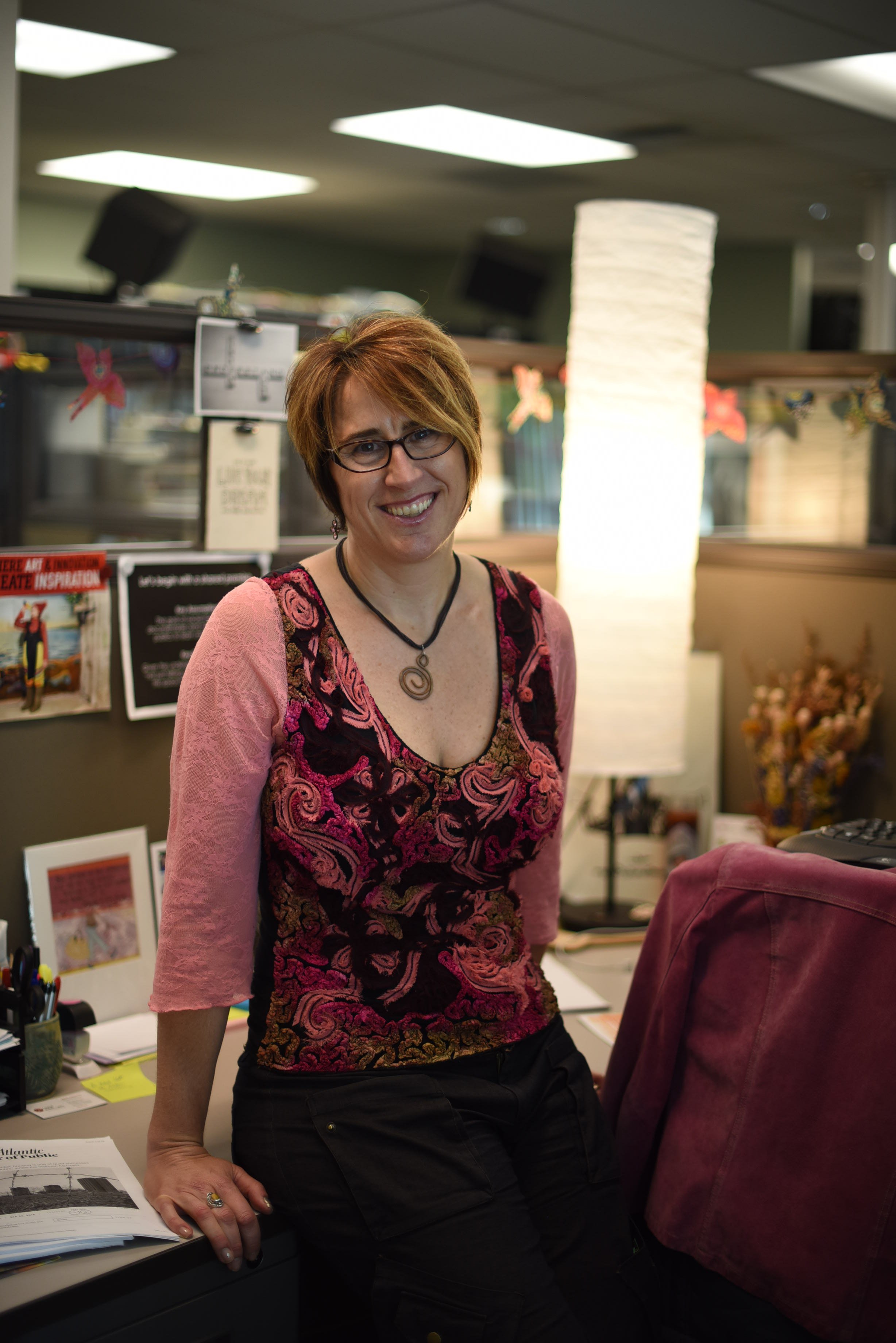
jesikah maria ross at CapRadio. Photo by Jenny Yarmoluk.
How do you view your role within a larger Sacramento creative ecosystem?
DD: I view myself as an artist and a Black, female, descendant of immigrants; I contribute my perspective and cultivated experience as a human here on Earth on canvases, and pieces of paper. As a digital art curator, I am able to draw back to these realities, actively searching and understanding artists of similar and unfamiliar backgrounds, genres, and locations. I feel strongly about the involvement of diverse artists and genres. If Sacramento is known for the prominence and wide breadth of cultures, it’s important to remain true to that fact by supporting the unknown — as a citizen from the city of Sacramento, an art curator, and an artist.
BS: There is a lot of incredible work being produced in Sacramento, and a real lack of arts-focused press outlets. If Sacramento is an “arts city”, then we need more focus on the stories of arts practitioners in order to elevate and celebrate their contributions to our City. That became the aim of the articulator project: to increase the awareness and elevate the creative sector through in-depth interviews with cultural and creative community leaders, expressing the challenges and opportunities they have in building and supporting the creative economy.
jmr: In terms of the larger ecosystem, I’d say I’m more of a conductor — supporting an orchestra of community and professional storytellers so that they can do their best work, while collaborating to amplify lesser-heard voices and issues.
What does your day-to-day process look like? Do you have interviews, long periods of writing, lots of meetings . . . ?
BS: My day is equal parts interviewing, writing, and fundraising. Interviewing and fundraising require a lot of meetings; writing requires isolation. The articulator project provides a nice balance.
JMR: I start each day by taking what I call a “creative stance”: 60- 90 minutes of reading, reflecting and/or making. It’s my way of ensuring that every day I start out exercising my creative muscles and getting inspired by what’s happening in my fields of practice (documentary, public radio, community art).
Do you view your work as a creative act itself? Why?
PF: I view my work more as a response to a creative act that has already happened. If something catches my eye I always want to share it with other folks.
jmr: Absolutely! Everything that I do I have never done before — which is equal parts exciting and nutty. I’m always inventing; knitting together ideas from different disciplines, conversations, and experiences. And I’m always working with new partners and in different geographic communities on projects that build community resilience, while producing powerful stories for CapRadio listeners. For me, it's a profoundly creative exercise.
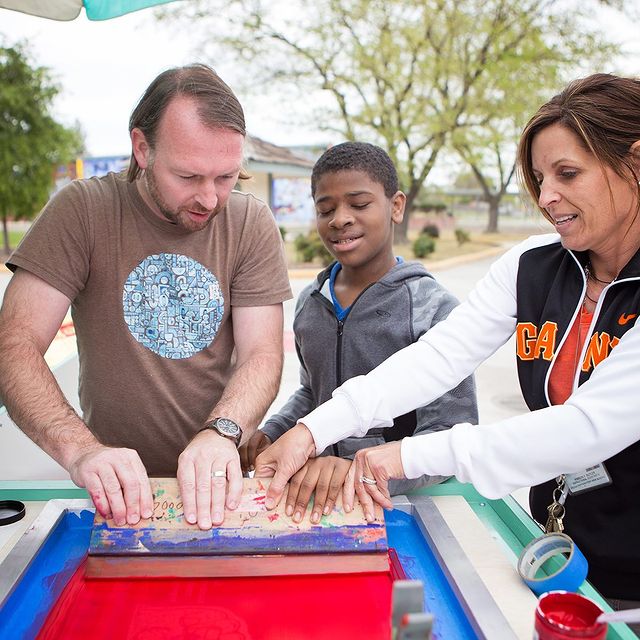
Peter Foucault (left) demonstrates how to create a screen print on a portable printing lab he created.
What do you savor most about the work you do?
DD: You would think that, as an artist, it would be about the art, but genuinely the core value stems from the initial belief of helping people. Growing up, my mother was very charitable. I would watch her help people she knew well and even complete strangers as if she knew them all her life. The benefits of helping others has a very satisfying and self-reflective effect on the soul. It gives me a purpose.
BS: It’s the people I’ve met and the relationships that have evolved from this project that I savor the most.
jmr: I love orchestrating gatherings where people who wouldn’t ordinarily cross paths come together and grapple with social issues and each other’s messy experiences of the, where powerful personal story-sharing generates frank conversation — the kind that busts stereotypes and generates emotional border crossings — in an atmosphere that is beautiful, respectful, and relevant. It’s always better when it involves food, music, and collaboration with community leaders.
Is there anything exciting you are seeing in the arts in Sacramento right now?
DD: I for one am extremely proud of the creatives of this city, for responding to the elemental events that have taken place this year. From the pandemic, to the spark in the Black Lives Matter Movement, California fires, and even the chilling month of October . . . emotion and anxiety have fueled Sacramento artists in a way I have never seen before.
PF: Several exciting things are happening in Sacramento right now. We are seeing many nontraditional and alternative art spaces safely bringing in-person exhibition programming back at a time when it is more difficult for larger organizations to make that happen. The Garage on the Grove (TGTG) put on a stellar exhibition of Vincent Pacheco: Smile Now, Cry Later. Maren Conrad created I Vote: 100 Years of the 19th Amendment, a new mural commemorating the power of the female vote installed along the Weave Building. I feel very blessed to be working in a City that is giving back so much to the creative sector through overwhelming financial support through government Pandemic Assistance and the CARES act.
BS: Despite the pandemic, Sacramento has a thriving arts scene and support system. With the help of so many organizations (Sol Collective, Atrium 916, Broad Room, The Brickhouse Gallery, Verge, Celebration Arts, to name a few) people are figuring out how to reinvent their careers as creatives by learning new business practices and finding new outlets for their art. It always amazes me how adaptable artists can be, and seeing that through this difficult time is truly inspiring.
We need to move past sound bite journalism and trust that people will spend 20-30 minutes to read an interview or a story about the arts.
What can be done to grow support for critical arts coverage here in Sac?
DD: I believe that this marketing platform known as ADS is the missing piece to promoting the art scene here in Sacramento. Going on 12,000 followers worldwide — and with a hashtag of 42k+ — now is the time to take advantage of the services offered by this homegrown service to get the word about our art scene to the world.
PF: Having more arts coverage in mainstream media outlets with a larger readership — such as the Sac Bee. Adding an arts critic to their staff with a consistent presence and regular column would be a huge asset.
BS: We need to move past sound bite journalism and trust that people will spend 20-30 minutes to read an interview or a story about the arts in Sacramento. If the story is compelling and the visuals are engaging, I believe people will slow down and take the time to really get to know our arts community.
About the Writers
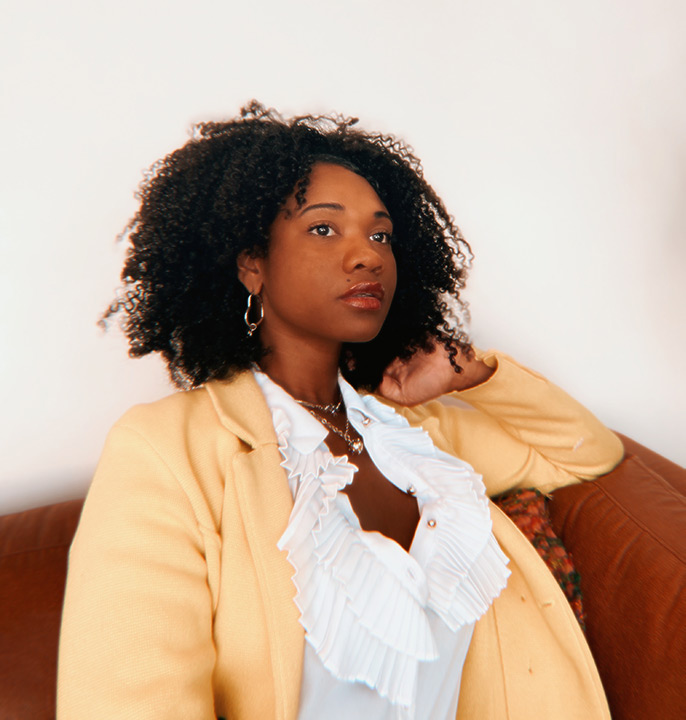
Desaree' Lynee' Deckard — or Duckee — is a painter, illustrator, and designer, as well as the creative force behind Art of the Day Sacramento, which has promoted organizations such as Wide Open Walls Mural Festival, Sacramento Arts Festival, Summer Valley Spark’s Drive Thru Art Experience, Oak Park Neighborhood Association’s, “Imagine A New World” Chalk Project, Girl Gang Craft, Name the Docks Old Sacramento project, and Sacramento State University’s Center for Immigration and Social Justice to the platform’s worldwide audience. She was recently featured on Good Day Sacramento with Oak Park Brewing Company for their “Paint the Globe” silent auction.
Peter Foucault
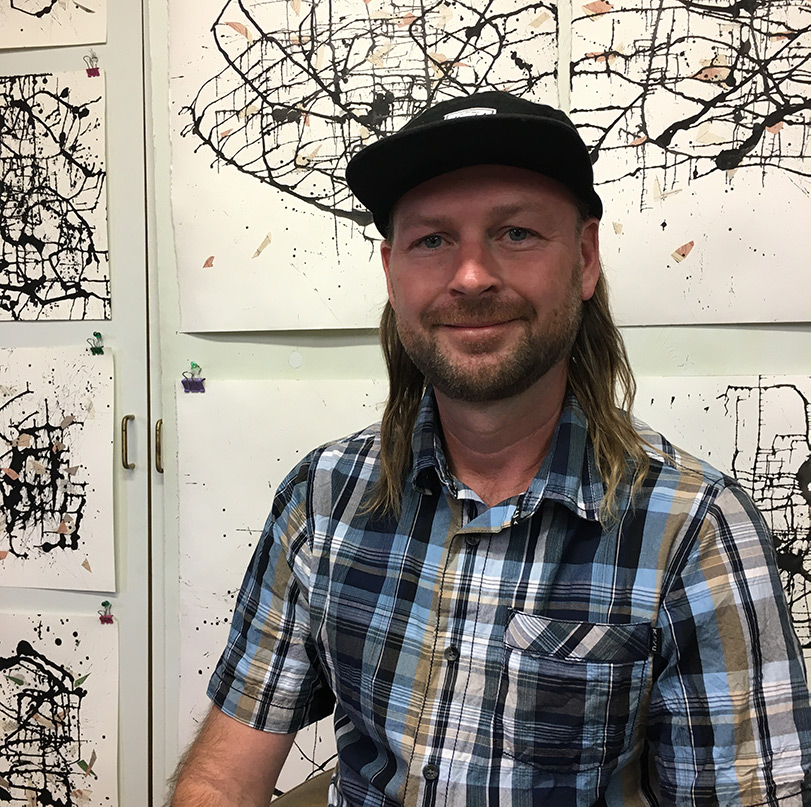
Peter Foucault creates works on paper, videos, and installations that are fueled by his love of drawing and mark making. In addition to his own practice, he is the Co-Founder of the Mobile Arts Platform (MAP), an artmaking and curatorial team that creates interactive exhibitions that directly engage the public. Foucault has participated in exhibitions at venues such as the Getty Museum and Getty Villa, Oakland Museum of California, Torrance Art Museum, California Museum, San Luis Obispo Museum of Art, Yerba Buena Center for the Arts, Smithsonian Institutes’ Freer and Sackler Gallery, Kit Schulte Contemporary (Berlin, Germany), The University of Salford (Manchester, England), and The Orange County Center for Contemporary Art.
Foucault has received funding from the California Arts Council, Creative Work Fund, Wattis Family Foundation, the City of San Jose Public Art Program, the City of Oakland’s Cultural Funding Program, US Bank, the Seattle Center Foundation, Puffin Foundation and the Zellerbach Family Foundation. Foucault’s work has been reviewed in People Magazine, KQED Arts, The San Francisco Chronicle, The SF Weekly, ArtWeek, Wired Magazine, KTVU Fox News, ABC 7 News, CBS Bay Area News, and Artnet Magazine.

Bill Stotler is the writer and photographer of the articulator project. His strengths are the ability to create meaningful relationships, collaborating with partners, and developing and implementing sustainable business structures. Throughout his career, he’s held many irrelevant positions including Business Strategist & Management Consultant, CEO, Director of Marketing & Business Development, VP of Events and Development, and Director of Sales & Marketing.
articulator is a series of conversations with Sacramento-based artists and makers. Shared online and in print, these narratives capture the challenges and opportunities in growing and sustaining Sacramento’s creative communities. This project aims to promote the creative economy in Sacramento through personal storytelling. These biographies include perspectives on building and supporting the creative community, workforce development, the Creative Edge Plan, and entrepreneurship in the arts. Preorders for the Sacramento Edition are now open. The 230-page, full-color book features six interviews with artists Barbara Range, Gioia Fonda, Estella Sanchez, Liv Moe, Trisha Rhomberg, and Harley White, Jr., as well as the work of Aida Lizalde, Shonna McDaniels, Penelope Lenaerts, Xico Gonzalez, Manuel Rios, and Milton 510 Bowens.
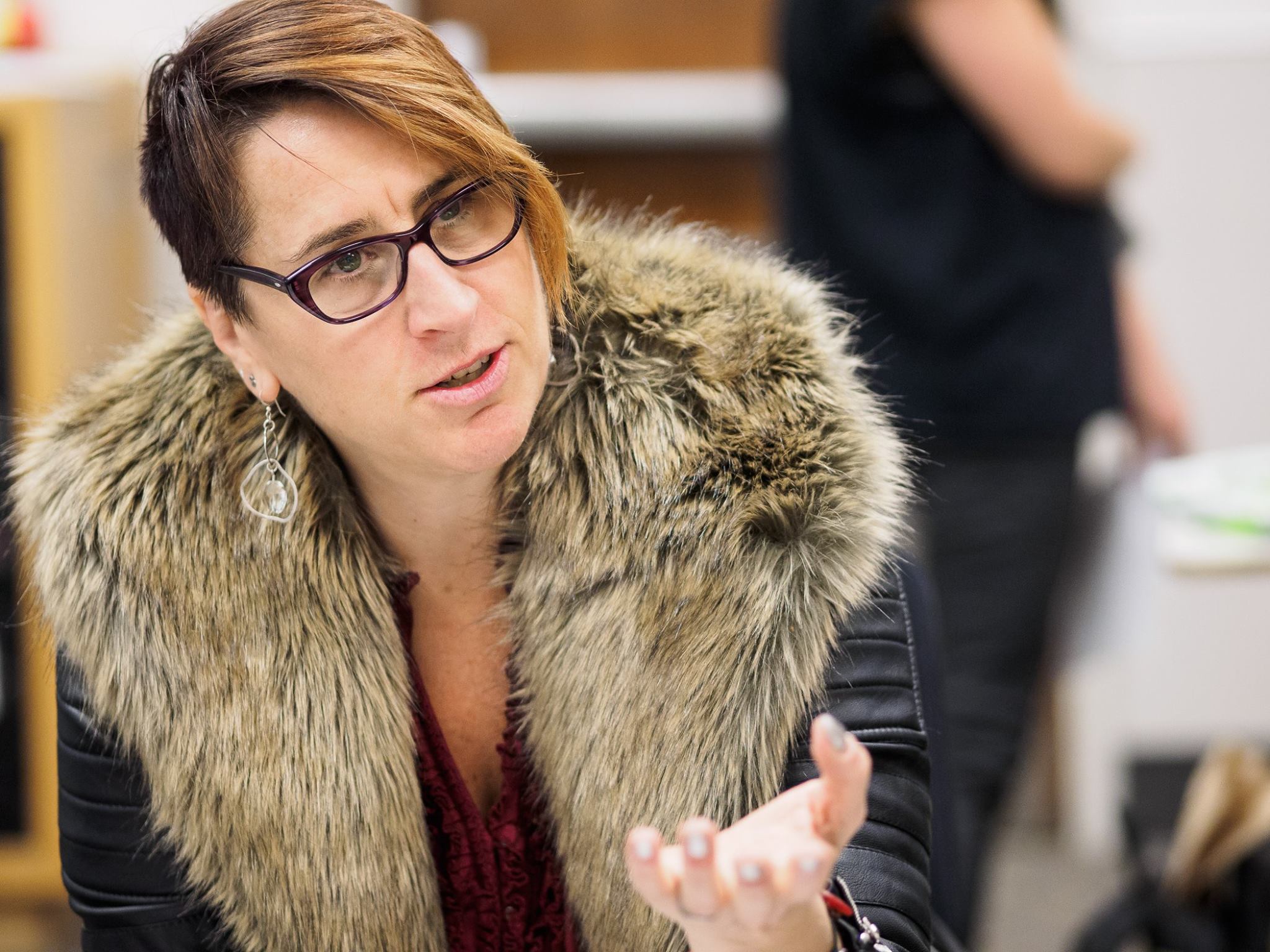
jesikah maria ross is an interdisciplinary artist who is changing how we collect, share, and tell the stories of our communities. She mobilizes people–stakeholders, groups, youth and those on the sidelines — around a shared interest, creating spaces and processes that catalyze social change. Her productions braid together citizen storytelling, documentary mediamaking and community conversations to produce podcasts, interactive websites and dynamic storytelling events. jesikah is the Senior Community Engagement Strategist at CapRadio, the NPR affiliate in Sacramento, California. jesikah is out to make a difference and believes that wit, grit and imagination can take us where we need to go.
Top image, from left to right: Artists Taylor Pannell, Didier Mponte, Desaree “Duckee” Deckard, and Hus at the third "In Living Color" art show in 2019.
About the author: Houghton Kinsman works as the Adult Education Coordinator at the Crocker Art Museum in Sacramento, California. He holds a Master of Fine Art in Art from the University of Cape Town, South Africa and has previously served as assistant to the Curator of Education at the Museum of Contemporary Art, North Miami. His writings have appeared in Art Africa, Contemporary And, Dazed and Confused, Frieze, and Artthrob.


